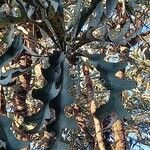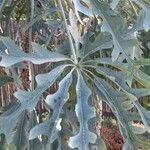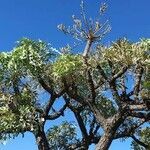A small tree. It grows up to 5 m tall and has few branches. The trunk is rough, brown and corky. The bark is grey and cracked along its length. The trunk can be 60 cm across. The branches have prominent leaf scars. The leaves can be 60 cm across. They are made up of 7-9 leaflets arranged like a fan. The leaflets are entire and lobed. The form segments with constrictions between them. Each leaflet is 10-30 cm long by 2-6 cm wide. They are a pale blue-grey. The edges are toothed. The flowers are small and green. They occur in densely flowers spikes. These are 2.5-5 cm long. They are branched. The fruit is fleshy and 6 cm across. They are purple when mature.
Leaflets 7–9(13), up to 27 cm. long, sessile but with long narrow cuneate bases, in some cases becoming almost petiolate, deeply pinnatifid, very variable with the sinus extending sometimes almost to the midrib, but in others only reaching halfway from the margin; lobes equally variable in width. Apex broadly acute with a short terminal mucro; margin sometimes with a few small teeth.
Spikes subtended by inconspicuous basal bracts and with distinct peduncles up to 5 cm. long. Fertile parts of the spikes at first clearly shorter than the peduncle, but later elongating and often exceeding the peduncle in fruit.
Fruit subglobose, distinctly fleshy and pea-like (showing clearly the 2 carpels when dry); mature fruit sometimes only setting rather irregularly on the spikes, with many infertile flowers.
Inflorescence a group of panicles, each bearing racemosely arranged spikes in subopposite pairs. Main axes up to 35 cm. long, glabrous, finely but distinctly grooved.
Thick-stemmed tree to 5 m. Leaves glaucous, digitate, leaflets sometimes toothed or lobed above. Flower spikes paniculate, green.
Leaves digitately compound, with very long petioles up to 50 cm. long.
Lamina glabrous and with a distinctly glaucous sheen beneath.
Floral bracts minute, more or less lanceolate.
Flowers sessile, stylopodium depressed.
Small tree up to 5 m. high.




